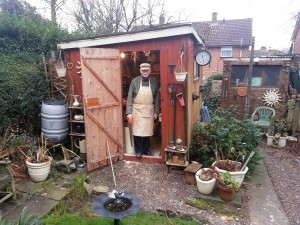Editor’s Note: The following blog series, ‘Chips from the Chisel’ is John Gainey’s experience as a carpenter and joiner apprentice on the Cardiff Docks in South Wales from 1955-1960. John’s garden woodworking shop was featured in the November 2013 issue of Wood News Online.
CLICK HERE to read Part 1.
CLICK HERE to read Part 2.
CLICK HERE to read Part 3.
After expressing my opinions on the “old time” use of hand tools, I hope I’m not misunderstood. I am not advocating we should go back to the days of the saw pits with the frogs and sweat. I haven’t got a misplaced romantic view of hand tool use. Today’s machines are wonderful and well into the price range of all. There is nothing like having the stock on the bench, machined accurately to the required sizes, all square and true and ready to be worked on.
I remember being on site, working on a hardwood threshold sill. At the time I was using an electric hand planer to reduce the stuff. Even that was hard work. The gaffer or boss came along, an entrepreneur type (camel hair coat, cigar in mouth) with his hands in his pockets who said in a derisive tone “I don’t know what my grandfather would have said about using electric tools to do your work today.” My reply to that was “I would think he would have been overjoyed to own this and any other tool that eased up on the back-bearing jobs we sometimes have to do. It would have reduced wear and tear on his hand tools and his poor body if they were available in his day.
The changes I saw and have seen have had a profound affect on the craftsman’s life even then. GWR became BR (British Rail) affecting pay and conditions. Diesel engines replaced coal fired engines, which equaled job loss (no need of firemen). Ship containers on dockside equaled job loss (less dockers). The electric drill became widely used and was part of the tool kit. It changed the whole aspect of working tools, which equaled more speed and proficiency.
Sadness at Times
There was a sadness at times with the old timers and their tools. Every second hand shop contained wooden moulding planes for sale for 5s. Any bead (ovolo, round, or hollow) could be purchased when needed. They were examined thoroughly. The blade not pitted, the wood not split or worn down, and the name stamped on the heel. As they were held, thoughts of “I wonder who he was, what conditions did he work under?” It was always tinged with sadness.
Also, each second hand shop contained a number of carpenter’s tool chests. These were no doubt put in by his window. Perhaps he hadn’t returned from the war. Perhaps he had no son and heir. Or perhaps she just needed the money.
I always felt I was trespassing and had no right to be in his box when the shopkeeper opened the lid and exposed all of his tools and bits of pieces of the craft for all to see and for me to choose a tool I needed at the time.
Then one day they were all gone. Americans came over and bought every moulding plane they could find for the antiques market.
There was also sadness when an old timer was retiring. The tradition was to give each apprentice a tool from his box to help us in our career. I had a dovetail saw given to me that I used for many, many years and always thought of the craftsman every time I used it.
Sadness too was when one day, as I was employed as a maintenance carpenter on a housing estate, I saw lying in the roadway gutter a wooden jack plane that was sadly without its wedge and iron. I picked it up and looked for the name stamp and was so surprised to see the name on the heel. It belonged to an old-timer, Ted. I had worked with him as an apprentice. I could not believe it, what a coincidence. How did it get there? What happened to Ted? Why was his plane lying in the road? It was so sad.
In Conclusion
Yes, the workshop was full of self respect, pride of work, traditions, skills and methods, knowledge and experience.
Unwritten laws that were duly kept:
- Do not touch another man’s tools without permission.
- Do not work on his bench without permission.
- Do not open his tool box without permission.
- A place for everything and everything in its place.
- No matter what the job, do it well.
We apprentices learnt them and obeyed them without question, and then passed it on to the next new apprentice.
The skilled craftsman is an artist and artisan still waiting to learn. A patient and tolerant man set apart from other men by the nature of his skills, with a great material he is using, steel or wood, glass or clay, iron or copper. The tools he uses become part of him, old friends. The shape, the size and weight, familiar to his hands.
To be able to answer the question sometimes asked “what do you do?” with the words “I am a carpenter and joiner” still makes me feel so proud. To be a carpenter seems the most natural thing in the world to be.
THE END



Such a Great article, Respect toward one another is the key word here the way it should be!
Thank You.
😉